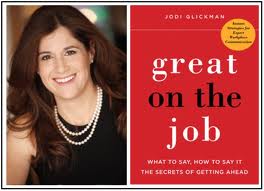I am in the process of reading/reviewing Jodi Glickman’s book Great On The Job – What To Say, How To Say It – The Secrets of Getting Ahead. Jodi has an impressive list of college clients, two being Harvard and Cornell, that bring her in to prepare their students for success on the job. As I go through it I will share some thoughts that make me go Hmmmm . . . This posting is based on one of those moments.
I think our society is confused when it comes to feedback. We lighten it with kids, with the intention of preserving their self esteem. We worry  about Millennials because the research says they need more. In fact, at the height of the economic meltdown a study was done about what motivates people and managers said “positive feedback/thank you”, while their people said “making progress on my work”. So what is the bottom line for feedback?
about Millennials because the research says they need more. In fact, at the height of the economic meltdown a study was done about what motivates people and managers said “positive feedback/thank you”, while their people said “making progress on my work”. So what is the bottom line for feedback?
Jodi Glickman addresses the topic with new/soon to be new graduates in a way that anyone can benefit.
First, she shares a window – asking for it once a year is not enough and once a month is too often.
Secondly, she shares a very simple method for setting up the situation so the feedback can be given and has value for both the leader and the individual. The two steps are:
- Phase I: Preparation
- Phase II: The Conversation
While both are good steps, I love Phase I. Too often I see people jumping into a deep conversation with a peer or leader with no preparation for the person being asked to give it. It usually ends with something generic like “It was great”. Glickman’s quote about feedback that should be posted on cubicles everywhere is:
. . . the goal of the feedback is not to make you feel good. The goal is to make you better at your job. (p. 129)
The author points out the best way to setup a good feedback session is to plant the seed before asking for feedback. For example, if your focus is presentation skills, maybe planting the seed would sound like this: “Julie, I am really trying to focus on my presentation skills, so could I ask a favor? I’d welcome some feedback on my presentation after our client meeting next week. If you could jot down some thoughts, I will setup some time for us to talk the following week.”
 This builds off a core belief I have around Building Rhythm(from my trUPerformance™ model) in how we talk about our work, our priorities, and our needs. Inherent in the one one one template I use with clients is the routine nature of our conversation and the predictable topics so feedback is continually mined (both positive and negative) without having to ask for it.
This builds off a core belief I have around Building Rhythm(from my trUPerformance™ model) in how we talk about our work, our priorities, and our needs. Inherent in the one one one template I use with clients is the routine nature of our conversation and the predictable topics so feedback is continually mined (both positive and negative) without having to ask for it.
Talent management is about great conversations. This book is loaded with tips on how, as a follower, to make those happen.
The final review of this book is coming next month, but so far I have really enjoyed the content and the way it is presented.
